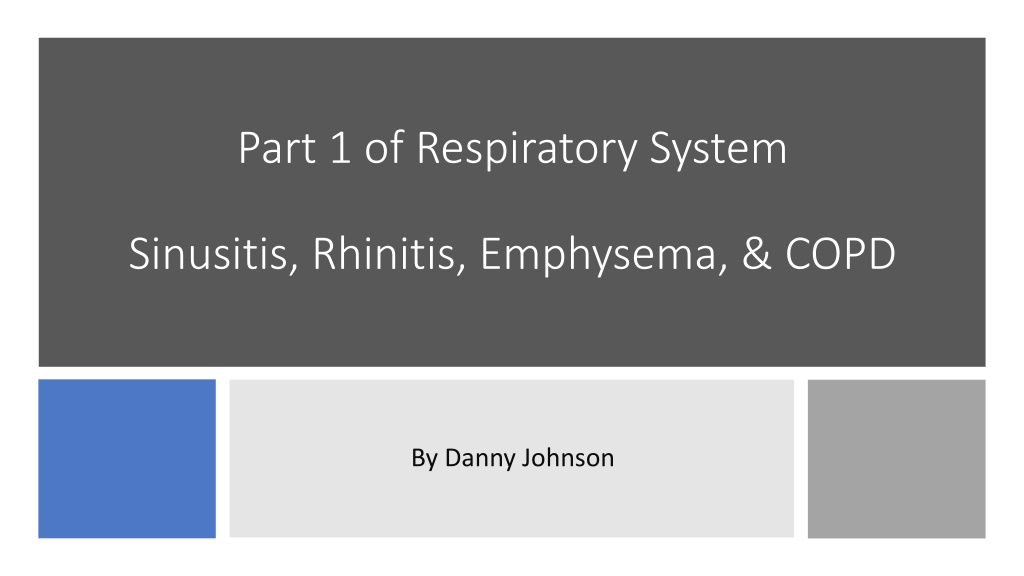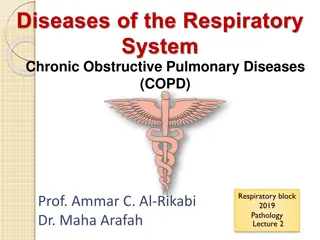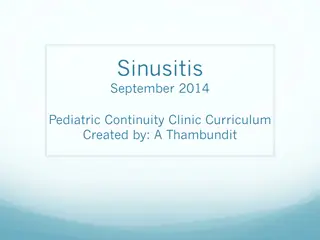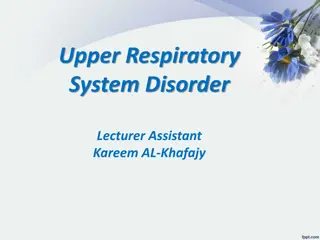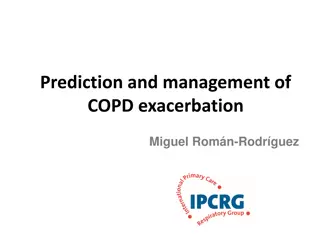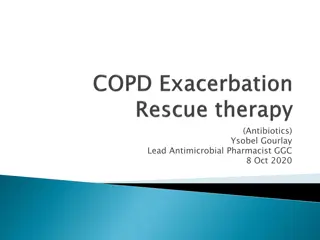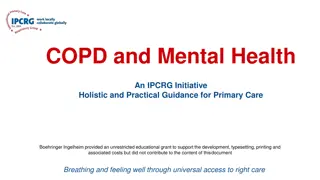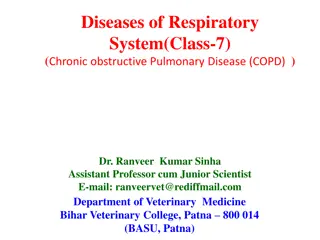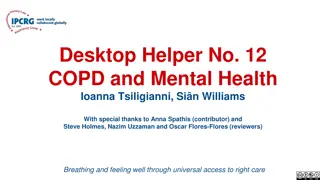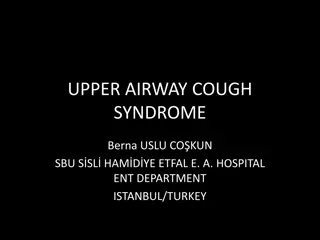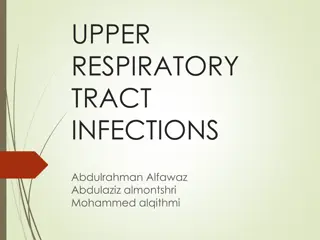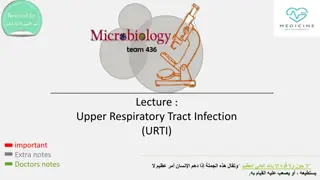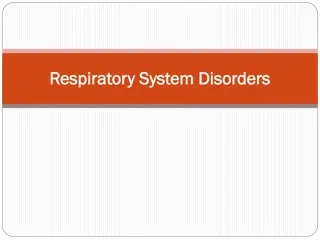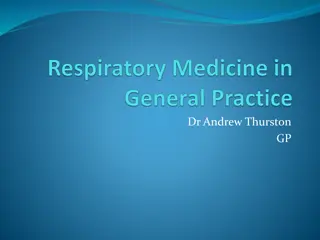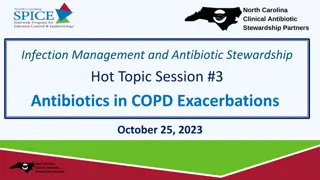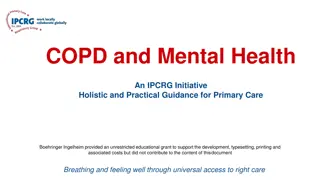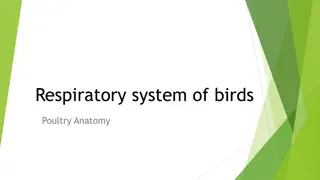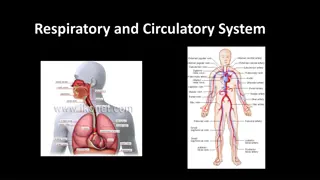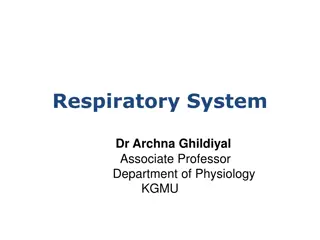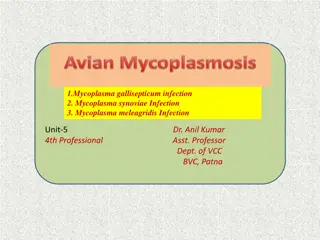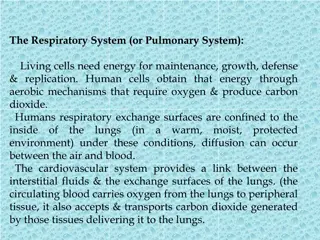Understanding Respiratory System Disorders: Sinusitis, Rhinitis, Emphysema, and COPD
This informative content delves into common respiratory issues such as sinusitis, rhinitis, emphysema, and COPD. It provides detailed information on the symptoms, diagnostic criteria, and rating formulas for each condition. The content also touches upon military service-related respiratory problems. Visual aids and explanations enhance the understanding of these respiratory disorders.
Download Presentation

Please find below an Image/Link to download the presentation.
The content on the website is provided AS IS for your information and personal use only. It may not be sold, licensed, or shared on other websites without obtaining consent from the author. Download presentation by click this link. If you encounter any issues during the download, it is possible that the publisher has removed the file from their server.
E N D
Presentation Transcript
Part 1 of Respiratory System Sinusitis, Rhinitis, Emphysema, & COPD By Danny Johnson
Respiratory System
served Respiratory Issues with Military
Sinusitis General Rating Formula for Sinusitis (DC's 6510 through 6514): Following radical surgery with chronic osteomyelitis, or; near constant sinusitis characterized by headaches, pain and tenderness of affected sinus, and purulent discharge or crusting after repeated surgeries 50 Three or more incapacitating episodes per year of sinusitis requiring prolonged (lasting four to six weeks) antibiotic treatment, or; more than six non-incapacitating episodes per year of sinusitis characterized by headaches, pain, and purulent discharge or crusting 30 One or two incapacitating episodes per year of sinusitis requiring prolonged (lasting four to six weeks) antibiotic treatment, or; three to six non- incapacitating episodes per year of sinusitis characterized by headaches, pain, and purulent discharge or crusting 10 Detected by X-ray only 0
Respiratory System
Rhinitis 6522 Allergic or vasomotor rhinitis: With polyps 30 Without polyps, but with greater than 50-percent obstruction of nasal passage on both sides or complete obstruction on one side 10 6523 Bacterial rhinitis: Rhinoscleroma 50 With permanent hypertrophy of turbinatesand with greater than 50-percent obstruction of nasal passage on both sides or complete obstruction on one side 10 6524 Granulomatous rhinitis: Wegener's granulomatosis, lethal midline granuloma 100 Other types of granulomatous infection 20
Respiratory System
6604 Chronic obstructive pulmonary disease: FEV-1 less than 40 percent of predicted value, or; the ratio of Forced Expiratory Volume in one second to Forced Vital Capacity (FEV- 1/FVC) less than 40 percent, or; Diffusion Capacity of the Lung for Carbon Monoxide by the Single Breath Method (DLCO (SB)) less than 40-percent predicted, or; maximum exercise capacity less than 15 ml/kg/min oxygen consumption (with cardiac or respiratory limitation), or; cor pulmonale (right heart failure), or; right ventricular hypertrophy, or; pulmonary hypertension (shown by Echo or cardiac catheterization), or; episode(s) of acute respiratory failure, or; requires outpatient oxygen therapy. 100 COPD (chronic obstructive pulmonary disease) is a group of lung diseases that make it hard to breathe and get worse over time. The two most common type of COPD are: Emphysema affects the air sacs in your lungs, as well as the walls between them. They become damaged and are less elastic. Chronic bronchitis, in which the lining of your airways is constantly irritated and inflamed. This causes the lining to swell and make mucus. FEV-1 of 40- to 55-percent predicted, or; FEV- 1/FVC of 40 to 55 percent, or; DLCO (SB) of 40- to 55-percent predicted, or; maximum oxygen consumption of 15 to 20 ml/kg/min (with cardiorespiratory limit) 60 FEV-1 of 56- to 70-percent predicted, or; FEV- 1/FVC of 56 to 70 percent, or; DLCO (SB) 56- to 65-percent predicted 30 FEV-1 of 71- to 80-percent predicted, or; FEV- 1/FVC of 71 to 80 percent, or; DLCO (SB) 66- to 80-percent predicted 10
6603 Emphysema, pulmonary: FEV-1 less than 40 percent of predicted value, or; the ratio of Forced Expiratory Volume in one second to Forced Vital Capacity (FEV- 1/FVC) less than 40 percent, or; Diffusion Capacity of the Lung for Carbon Monoxide by the Single Breath Method (DLCO (SB)) less than 40-percent predicted, or; maximum exercise capacity less than 15 ml/kg/min oxygen consumption (with cardiac or respiratory limitation), or; cor pulmonale (right heart failure), or; right ventricular hypertrophy, or; pulmonary hypertension (shown by Echo or cardiac catheterization), or; episode(s) of acute respiratory failure, or; requires outpatient oxygen therapy. 100 FEV-1 of 40- to 55-percent predicted, or; FEV- 1/FVC of 40 to 55 percent, or; DLCO (SB) of 40- to 55-percent predicted, or; maximum oxygen consumption of 15 to 20 ml/kg/min (with cardiorespiratory limit) 60 FEV-1 of 56- to 70-percent predicted, or; FEV- 1/FVC of 56 to 70 percent, or; DLCO (SB) 56- to 65-percent predicted 30 FEV-1 of 71- to 80-percent predicted, or; FEV- 1/FVC of 71 to 80 percent, or; DLCO (SB) 66- to 80-percent predicted 10
Respiratory System
Fun Facts To help Veterans suffering from lung diseases like COPD, VA is funding research into the development of a 3D-printed artificial lung. The research, led by a team at the VA Ann Arbor Health Care System in Michigan, has a goal of building the first wearable artificial lung that is both compatible with living tissue and capable of supporting breathing. Development of the nicotine patch In 1984, VA research developed the nicotine transdermal patch, helping Veterans and others to quit smoking. The patch was developed by Dr. Jed Rose, Dr. Daniel Rose, and Dr. Murray Jarvik.
References https://www.benefits.va.gov/REPORTS/abr/ https://www.research.va.gov/topics/respiratory.cfm https://www.benefits.va.gov/REPORTS/abr/docs/2020_compensation.pdf https://www.ecfr.gov/current/title-38/chapter-I/part-4
